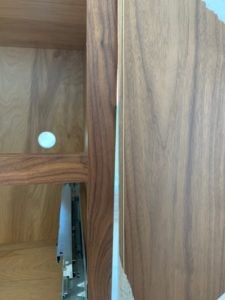Important Information about Veneer Vs Solid Wood
When you choose a Natural finish or even light stain, it’s important to recognize that veneers will not be a perfect match to the solid wood pieces of your project. We’re here to help you avoid frustration by explaining the reasons for these differences. Our hope that is that we can set realistic expectations and help you plan accordingly with your Cabinet Coach.
Why the Difference Occurs
First, let’s explore why this “mismatching” occurs. When logs go to market, veneer suppliers get the first pass at selecting logs. For various reasons, such as how veneer flitches are skinned off the log, logs must meet certain criteria for use. Because of this, the best logs are brought up first. Next in line are the lumber companies who require hard and softwood lumber to make things like flooring, cabinet doors, etc. Due to the selection sequence, the color tones and graining of the solid woods won’t match the veneers due to differences in the logs themselves. Some species like Walnut are the most prone to this color/grain variation.
It is important to recognize that Conestoga does not make the veneer, therefore they cannot control the color of the flitches used to manufacture veneered products. Also, the veneers and plywood Conestoga receives are considered “in spec,” meaning they can’t be rejected and sent back to the supplier even if they don’t match the solid wood. Trying to match the veneers/plywood Conestoga doesn’t manufacture with the solid wood they do would result in a huge amount of waste. That waste would translate to increased prices for customers.
An Example
So, what might this solid wood vs veneer difference look like? Below is an image from a natural Walnut project. The solid wood framing on the cabinet face frame (left) is noticeably darker than the veneer skin which will be applied to the cabinet side (right). What is shown in this image is within tolerance and would not be replaced under warranty.
The situation is workable when it is a veneered cabinet side versus the cabinet doors/face frame because they are at 90 degrees to each other and therefore the difference is not as obvious. However, if you are ordering plywood panel doors, your solid wood framing and the veneered center panel of the door can/will look noticeably different.
Tips for navigating this situation:
- Consider a stained finish. Any colorant (even a light stain) will help nullify the color difference. The darker the stain, the less obvious the difference.
- Use applied or integrated door panels. Differences in finished cabinet sides may look obvious upon final installation. Applied or integrated door panels will match your operable doors and create a better blend.
- Choose the right doors. We recommend selecting solid wood doors or all veneered doors (for example the Savoy) when using a natural or light stain. By choosing a solid wood frame and panel, Conestoga can pull lumber that blends nicely to create a uniform look.
- Look past it! We’re not trying to be flippant or funny here. While we live in an age filled with materials that can both replicate and repeat the look of wood, remember that you are ordering a natural product. Wood is an organic substance and therefore, it will vary. Learn to accept these differences as the things that make your kitchen unique and one of a kind!
In closing, remember that Conestoga’s own warranty calls out that differences in veneers and solid woods are not warrantied. So, while we fully understand your concern if your project exhibits these differences, please realize that we cannot do anything about replacements on the pieces. In fact, replacements could be just as ‘off’, if not worse.
Should you have any questions, please contact a Cabinet Coach. They are versed in the product and happy to guide you in making your selections.

